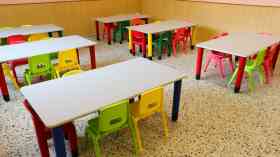Refurbishment for a heritage point of view

After a decade during which resources and investment reached levels never seen before, the schools capital programme now appears to face an uncertain future. The state of the public finances, together with the recent review of capital investment in schools led by Sebastian James, has prompted a rethink of how precious resources are spent on school buildings. Against this background, it is probably safe to assume that remodelling and refurbishing of existing buildings will form a large part of the short to medium programme.
From a heritage point of view, the James review contained some welcome recommendations – including those on the importance of a much more systematic approach to the collection and upkeep of robust condition data (and the way that this should inform future funding allocations) and maintenance of existing buildings. All school buildings, not just those that have heritage significance, need investment and systematic maintenance to ensure they remain fit for purpose and provide the best possible learning environment. The benefits of an up to date and functional school estate are now well understood – both in terms of student attainment and staff motivation.
SUSTAINABILITY
But, other than the importance of the upkeep of existing buildings or their architectural or historic significance, there are other factors at play that reinforce the arguments behind reusing existing school buildings. The increasing awareness of sustainability issues and the embodied energy within existing buildings (and the drawbacks involved in demolition and replacement) together with the ongoing surge in
the birth rate in England also mean that the days of discarding school buildings and replacing them have probably come to an end. Indeed, it’s worth noting that a significant proportion of the proposed ‘free schools’ that have moved to the business stage case are planning to use listed buildings originally constructed as schools as part of their estate.
Where school buildings are listed, either nationally or on a local list, their significance will play a factor in how they are reused. Listing does not mean that buildings cannot be altered or remodelled – but simply that proposals for change and redevelopment need to be justified in proportion to the significance of the building in question. There have been many successful examples of historic buildings being refurbished and remodelled in recent years to ensure that they remain fit for educational purposes for many years to come. Some of these have been radical interventions to the fabric of historic buildings, while others have simply been sympathetic refurbishments that have refreshed the external appearance.
LESSONS LEARNT
So what do recent projects involving historic buildings have to offer in the way of insights and strategies for successful refurbishment projects? There are three main areas where issues arise.
Get expert advice at the right stage. It is obviously important that decisions on the future of historic school buildings are not taken in isolation from appropriate advice and guidance on heritage issues. Local authority staff dealing with capital investment should seek the appropriate advice at the earliest possible stage – levels of risk rise where redevelopment proposals have been drawn up without this kind of advice, and it can result in delays and cost overruns.
Windows should also be considered. Many historic school buildings retain their original windows. Given budget constraints, there can be a tendency to replace original sash window to with the intention of achieving lower maintenance costs over the long term. However, this kind of intervention clearly has an effect on the significance of the building.
Alternatives to replacement are often possible – recent research undertaken on behalf of English Heritage has demonstrated straightforward and practical ways of significantly improving the energy performance of traditional sash windows. Secondary glazing, draught proofing or the fitting of blinds can all dramatically improve the level of heat loss, in some cases by over 60 per cent.
CONTEXT
Where listed buildings form the ‘core’ of a school, there has been a recurring theme in refurbishment projects over recent years where poor quality and out of context later additions and extensions have been removed as part of the redevelopment.
Investment in historic buildings is clearly a positive move on many levels – it allows updating and modernisation of the schools, as well as enabling the replacement of these types of buildings with accommodation more in keeping with its surroundings and context, and which will hopefully prove to be of better longevity.
But it also serves as a reminder that when it comes to updating and modernising such schools, we need to take a long term view – we shouldn’t simply be creating the conditions for the same problems to reoccur thirty or forty years from now, where buildings and extensions from the early 21st century are regarded as obstacles to modern education and end up being demolished and replaced yet again. Refurbishment, remodelling and extension projects on historic schools need to take proper account of their context and ensure that new development is sympathetic to what already exists in design, size and materials.
SUCCESSFUL STRATEGIES
Achieving successful outcomes in redeveloping historic school buildings depend in large part on two key principles – Planning Policy 5 (PPS 5): Planning for the Historic Environment and the Constructive Conservation philosophy.
PPS 5 sets out guiding principles for the management of ‘heritage assets’ within the planning system and essentially means that proposals for change should be proportionate to their degree of significance. It also makes clear that assessments and understanding of the significance are crucial ahead of development of proposals – thereby removing unexpected surprises and risk from later in the process. As part of this assessment, it is important to understand what or where the significance is – for example explaining where it appears, such as in the building fabric or plan form.
Constructive conservation is the philosophy behind the English Heritage approach to the modernisation and updating of sensitive and important historic buildings. It means taking what is special or distinctive about a particular building and actively managing the change or redevelopment to reinforce this particular character.
It is important to stress that English Heritage understands the need for school buildings to adapt and evolve to reflect the changing needs of staff and students and to be able to accommodate new methods of teaching and different ways of using space. Constructive conservation seeks to use what is special and significant about particular buildings in the pursuit of these aims – what this can mean is that radical interventions to the building fabric are entirely possible where proposals demonstrate understanding of significance and justification exists. Projects such as those at King Edward VII School in Sheffield have demonstrated the advantages that flow from this approach.
Walthamstow School for Girls
The refurbished and partially remodelled Walthamstow School for Girls in the London Borough of Waltham Forest (built in 1912 and listed at Grade II) recently won the BCSE award for best large scale refurbishment.
The project used the distinctive character and the landscape of the school site to guide the redevelopment – the classrooms within the main school building were refurbished to take advantage of their high levels of natural light and are now used by the languages and English departments, while specialist teaching in subjects such as science and technology subjects are accommodated in a new extension.
This takes advantage of a fall away in the ground level and inspiration from the existing layout of the grounds – so the extension contains a large amount of new space by having a lower ground floor and at the same time reducing the scale of the new against the old. There is also a new drama space creating a very striking junction with the original listed assembly hall.
The redevelopment has successfully created a modern and well equipped school while retaining and enhancing its historic character.
Eveline Lowe Primary School
Eveline Lowe School in the London Borough of Southwark was completed in 1967 and listed Grade II in 2006. Its design and layout was ground breaking at the time of its opening, and proved hugely influential both across the rest of the country and elsewhere in Europe. By 2007 changing education patterns together with pressure for school places locally led Southwark Council to consider the redevelopment of the site. The project refurbished the existing listed building, which is now used as resource, specialist and communal space and which acts as the hub of the school. A series of new (and deliberately modern) buildings have been constructed around the edge of the site to form an integrated enclosure to complement the central listed building.
Given the importance of ensuring that every school offers its pupils the best possible learning environment, Constructive Conservation is particularly appropriate for school buildings. It means being positive about adaptation of the historic fabric where it is sensible to do so, in turn meaning that the building can continue to accommodate new equipment and uses. Such an approach ensures that the inspirational surroundings offered by historic buildings are not denied to future generations of students, while also reusing finite resources in the interests of sustainability.
Latest News
19/12/2025 - 09:54
The Education Committee has expanded its ongoing inquiry into the early years sector to examine how safeguarding can be strengthened in early years settings.
18/12/2025 - 09:25
The UK will be rejoining the Erasmus programme in 2027, following a package of agreements with the EU.
17/12/2025 - 09:31
Ofqual has fined exam board Pearson more than £2 million in total for serious breaches in three separate cases between 2019 and 2023 which collectively affected tens of thousands of students.
16/12/2025 - 09:19
The average funding rates will increase by 4.3% for under 2s, and by almost 5% for 3-and-4-year-olds.
15/12/2025 - 10:30
Local colleges are set to receive £570 million in government funding to expand training facilities in areas such as construction and engineering.







